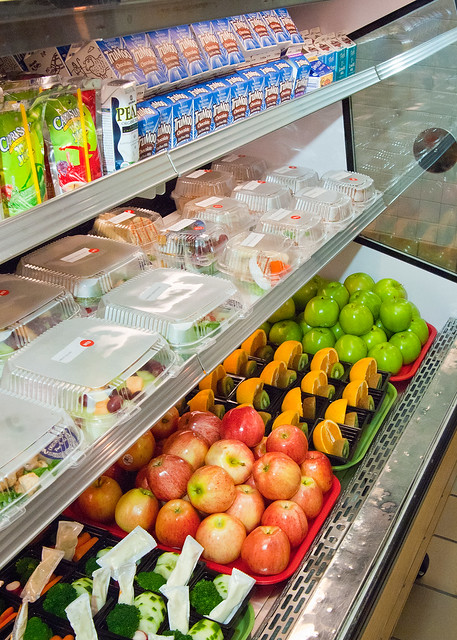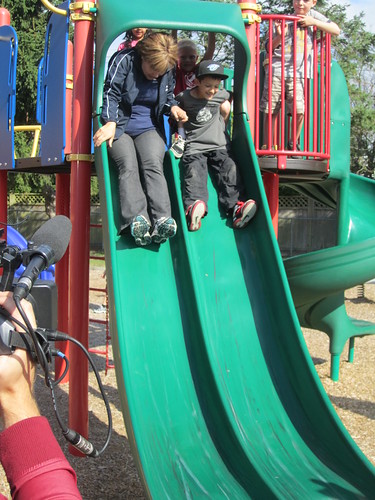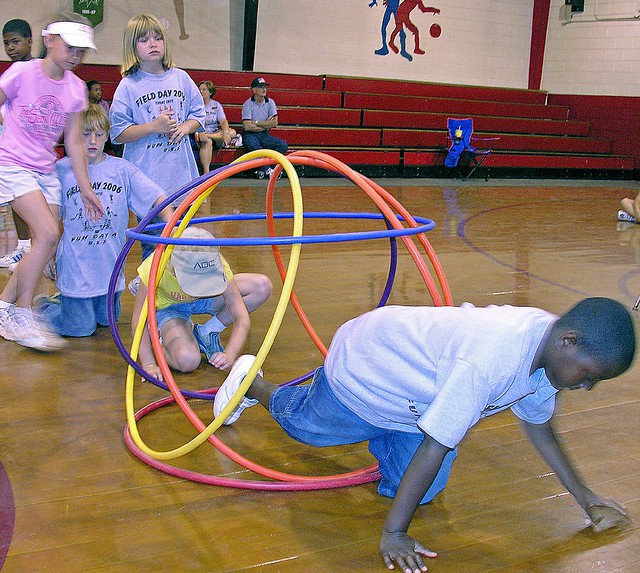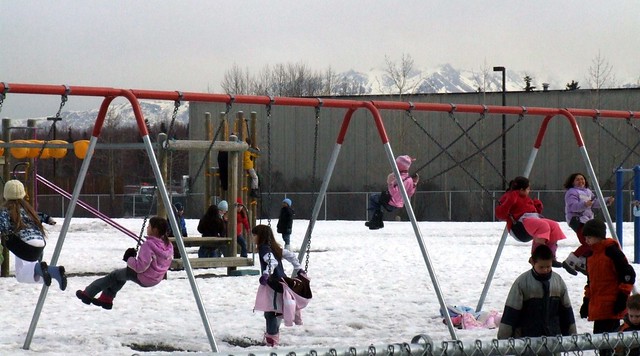What is Nutrition in Education: Workshops and After-School Programs
When I first started this blog, I spoke of how it was my dream to have nutrition education as part of regular school curriculum. As we know, this is a long way off. For most children, nutrition education comes in the form of after-school programs and workshops. Some nationally recognized after school programs include:
A great many programs exist on the local level also, frequently funded by your states Board of Education or by Extension Agencies, as well as the private sector and non-profit sector. For example, Girl Scouts in Kentucky is currently running a short nutrition education program for little girls through the school system ( I had the pleasure of going to one of these lessons with a fellow dietetics student earlier in the semester).
 |
Girl Scouts make fruit salad at a cooking class
by justjorie |
After school programs are important as the National Center for Education Statistics reports that only 35% of teachers provide stand-alone nutrition lessons to their students, and even when nutrition information is incorporated into other lessons such as the science of digestion or health science, children are exposures to an average of about 13 hours a school year. Considering children spend in excess of 700 hours of school this year, this number is fairly meager.
After-school and workshop nutrition education programs tend to address both physical activity and dietary behaviors. A literary review of such interventions reveals that such programs are responsible for modest changes in behavior, particular changes in behavior that promote weight maintenance and prevent overweight. For these two reasons alone, nutrition after school or as special events should be strongly encouraged in our schools.
Resources:
Labels: What is Nutrition Education
I have already spoken briefly about Physical Education when discussing the importance of recess as an element of Nutrition in Education. Mostly, I just spoke about the lack of vigorous activity children get during PE as a result of how the class is so frequently structured. This does not, by any means, indicate that children should not have PS classes as part of their curriculum.
Unfortunately, PE is one of those "elective"classes that when school budgets get cut, are sadly shown the door. Even when schools have PE classes, reductions in the time spent in PE have become common, as PE is not part of the standardized testing that schools are required to complete each year. Alarmingly more and more schools don't even have a gym for PE even if they still have a PE teacher. This is happening locally - in Clark County, Ky, they are currently building a new High School - a high school that will not have gym, as it is not in the budget. The adolescents of this school will have to ride a bus to the middle school in order to use the facilities. And most concerning - the school board does not see this as an alarming problem!
Rather that have you read about it, I actually found a fantastic video about the state of PE in our schools and its relationship to the obesity crisis. The video also features a number of PE teachers, physical education specialists and schools who are doing their part of make children more active inside and outside the PE classroom.
The good news is that there are people out there who understand the importance of physical activity and are leading the charge on change. Fitness Integrated with Teaching (FIT) Kids Act (H.R.1057/S.576) is a federal legislation has been re-introduced in the 112th Congress by
Representatives Ron Kind (D-WI) and Jim Gerlach (R-PA) in the House of
Representatives, and by Senator Tom Harkin (D-IA) in the Senate. The
bill would establish a framework for schools to closely look at the
quality and quantity of PE they are providing, and to supply parents
with that information to better understand the PE their kids are
receiving.
Unfortunately, this Bill has been stuck in senate for over a year. If you would like to help get the bill moving again the National Association for the Advancement of Colored People and the American Heart Association both have some awesome suggestions and form letters that you can add your details to and send to your Senators, available here and here respectively.
At the beginning of this blog we also discussed House Bill 68, which is specific to Kentucky schools. This bill would require a 45 minutes per week
of physical activity for half day kindergarten and 90 minutes per week for full day kindergarten
through grade five. Like the FIT Kids Act, this bill is also stuck in committee. If you would like to know more about this bill and what you can do to help move it along, visit this blog post.
If you are not from Kentucky and would like to know more about your states policies of physical education, you can visit this site which lists all policies relating to PE in each state.
Resources
Labels: What is Nutrition Education
What is Nutrition in Education: Recess
If you ask any child what their favorite part of the school day is, they will invariably say "Recess!". Recess is an important part of the day for a number of reasons - children need to be active, they need to be social and they need an opportunity to blow off steam. It is not, like so many schools have done, developmentally appropriate to remove recess time from a child's day. Few adults are able to attend their focus to monotonous tasks all day, and having this expectation for children is purely irrational. Recess is not only important from a Nutrition in Education point of view- but from all aspects of development.
Rae Pica, a children’s physical activity specialist provides 7 fantastic reasons why all children (and especially those with behavioral problems) need to have recess.
- Everyone benefits
from a break.
- Recess increases
on-task time.
- Children need
outside light to regulate the biological clock, improve move, support the immune system and to synthesis Vitamin D.
- Unstructured
physical play reduces stress.
- Children need to
learn to be social creatures.
- Our children’s
health is at risk when they do not have an opportunity to be physically active, regardless of weight status.
- Physical activity
feeds the brain.
Unfortunately, there is a trend in the United States towards "no-recess" policies in elementary and middle schools. School districts in Atlanta, New Jersey, Chicago, New York and Connecticut are among those implementing such polices - some to the point that playgrounds are no longer being built on new school properties.Other districts, including those in Georgia, Pennsylvania, Illinois, Texas, New Jersey, California and Florida are implementing reduction or elimination plans.
Frequently, it is cited that children do no need recess because they have physical education classes. However, this is not true for a number of reasons. Numerous studies have shown that children are simply not as physically active during PE as they are at Recess - frequently because of the utilization of team sports, such as baseball, by PE teachers in which many children stand and watch while 5-6 children are physically active. One study showed that in 30 minutes of a physical education class, the average child is only vigorously active for about 2 minutes. Not to mention that PE is a class, which means it deprives children of the social aspects of recess that are so important for their development.
Structured recess has been shown to increase physical activity among children. Structured recess is a concept in which teachers initiate and supervise games which encourage children to be active during recess. Playworks, a company that helps teach students and teachers how to encourage active play in the playground, helps explain the impact of structured play in the video below.
Resources:
S. J. Silverman and C. Dennis (2003). Student Learning in Physical Education: Applying Research to Enhance Instruction
Bazaliaki, N., Cox, D., Long, T., Risteen, J., Sparks, K., Ward, K. J. (n.d.). No recess- no way: Take back your time. Retrieved from http://www.timeday.org/pdf/recess_ban_paper.pdf
Pica, R. (n.d.) 7 reasons why kids need recess. Retrieved from http://www.movingandlearning.com/Resources/Articles30.htm
Pemerton, T. (2011). Oklahoma City schools try structured recess. Retrieved from http://newsok.com/oklahoma-city-schools-try-structured-recess-program/article/3548973
Labels: What is Nutrition Education
What is Nutrition in Education: School Food Environment
The school environment is a difficult concept to define, as it is a concept that seems fairly easily explained, but the more you examine the idea of school environment, the more expansive the concept becomes. The school environment encompasses the physical environment, the policies and procedures that shape the proceedings of the school and the attitudes attached to these proceedings. Not all aspects of the school environment are tangible, but a great many of them have an impact on healthy eating and physical activity of the students in which they preside.
 |
Visually appealing healthy foods promote healthy food choices
by USDAgov |
The CDC defines a healthy school environment as the physical and aesthetic surroundings and the psychological climate and culture of the school. Wechsler et al. further explain that environmental factors may be social, institutional or physical. Examples of social environment include role modeling and social norms (which can be defined by our peers, family or the media). Institutional factors include rules and polices, while physical factors include appearance and physical structures.
One of the most obvious aspects of the school environment, and one that we have discussed previous in this blog, is the availability of vending machines. At first glance, a vending machine is quite apparent as a physical structure. However, it is also an element of the school environment that is actively decided upon, meaning a policies exists as to when, if and how students can access the machine. How peers use the machine also has an affect on student uses. Suddenly a vending machine, which naturally has a direct impact on the dietary habits of students has numerous complexities in relationship to its involvement in the school environment.
 |
Children play more vigorously during recess when teachers engage them in play
by BC Gov Photos |
Environmental interventions are designed to (1) provide access to opportunities for engaging in health-enhancing behavior, while eliminating or weakening those aspects of the environment that make it easier for individuals to engage in health-compromising behavior, and (2) highlight positive role models, generate social support, and establish rewards and cues to action for engaging in health-enhancing behaviors.
- Wechsler et al.
I believe at this point there is no doubt in your mind that I could not possibly cover all the innumerable interventions to the school environment that could be made in order to improve health and physical activity behaviors of our school-bound youth, however, here are a couple of examples.
- Verstraete et al. found moderate physical activity can be increased in elementary children from 38 to 50% simply by providing children with play equipment such as balls, flying discs, skipping ropes, juggling equipment, and badminton ratchets and having teachers encourage use of equipment.
- Reicks et al have found that exposing children to photography of vegetables increases lunch line selection.
- Wechsler et. al examined the school food environment and found a number of environmental interventions that can improve physical activity and healthy eating behaviors
- There was a significant decrease in plate waste (children ate more of their lunch) when recess was scheduled before lunch.
- Access to school property such as gyms, basket ball and tennis courts outside of school hours increase physical activity and decreased juvenile crime. (This is a good reason to support Senate Bill 110!)
- 88% of high schools , 61% of middle schools, and 14%of elementary schools had food or beverage vending machines that students were allowed to use.
By reducing the price of nutrient dense foods in vending machines by 50%, sales of these food items increased from 26-46% of all sales.
Sources:
Centers for Disease Control and Prevention. Guidelines for school and community programs to promote lifelong physical activity among young people. MMWR 1997;46 (No. RR-6)
Verstraete, S J, Cardon, G M, De Clercq, D L , De Bourdeaudhuij, I M M, (2006). Increasing children’s physical activity levels during recess periods in elementary schools: The effects of providing game equipment. European Journal of Public Health, 16:4, 415–9.
Wechsler H., Devereaux, R. S., Davis, M., Collins, J. (2000). Using the school environment to promote physical activity and healthy eating. Preventive Mdicine, 31, S121-37.
Reicks, M, Redden, J P, Mann, T, Mykerezi, E, Vickers, Z, (2012). Photographs in lunch tray compartments and vegetable consumption among children in elementary school cafeterias. JAMA. 2012;307(8):784-785.
Labels: What is Nutrition Education
What is Nutrition in Education: School Meals
School lunches get a bad wrap... and honestly, they often deserve
it. They are supposed to follow strict guidelines, but sometimes the
stringency to which they are followed is more than a little
questionable. School lunches consist of a lot of breaded chicken product
and a lot of heat-and-serve, super processed food products. Do they
have to, no. But it's a lot less work for the foodservice workers, and a
lot less complaining in the lunch line if they are.
The Healthy Eating Index survey of children aged 2-17 finds that children have inadequate intake of fruits,
vegetables and whole grains. The NSLP is designed to meet 1/3 of a child's recommended intake for the day, and the School Breakfast program provides for an additional 1/4 of a child's dietary needs. these statistics show that the school meals that are served to over 31 million school children each school day may be falling short of their designated goals.
Meanwhile, children who eat school lunches are in general more adequately nourished and consume foods from a wider variety of food groups than those who eat a packed lunch. Condon et al found that while intake of these plant foods among children is
inadequate, NSLP
participants are more likely than nonparticipants to have an improved intake of
these food groups. Meanwhile, Clark & Fox found that NSLP
participation was associated with higher intake of calcium, potassium, and fiber
and reduced prevalence of inadequate intake of magnesium, phosphorous, vitamin
A, vitamin C, vitamin B6, folate, and thiamin.
This says very little for what is being fed to children by their parents - which brings us to another component of nutrition in education - reaching out to the families. I will have to go back, and add that one to our list of Nutrition in Education topics!
Condon et al: School meals: Types of foods offered to and
consumed by children at lunch and breakfast.
Clark & Fox: Nutritional quality of the diets of US publicschool children and the role of the school meal program Labels: What is Nutrition Education
What is Nutrition in Education?
How is nutrition in education defined? Ideally, I would like it to mean that children in every school, took a nutrition and life class along with math, science, reading and writing. No one have ever died from from spelling receive "R-E-C-I-E-V-E" or forgetting the formula for Pythagorean theorem. Meanwhile poor nutrition and a sedentary lifestyle has us dropping like flies.
But for now, that is little more than a pipe dream. Especially since we are currently facing battles like "kids should get a daily recess" and "pizza is a vegetable" on the school nutrition front.So, what are the topics that affect nutrition in schools?
The first one that comes to mind is school lunches - the actual food available in schools. The next most obvious is PE or "gym". After that, people may think of recess or maybe nutrition workshops or after-school programs.
Another consideration is the school food environment - say what? Well that covers things like the availability of sodas in vending machines, and the appearance of the cafeteria.And the of course there is nutrition as part of curriculum.
In the following days, I will post a brief explanation of these Nutrition in Education topics, because in order to advocate, we must first need to understand the beast we are about to battle!Labels: What is Nutrition Education






